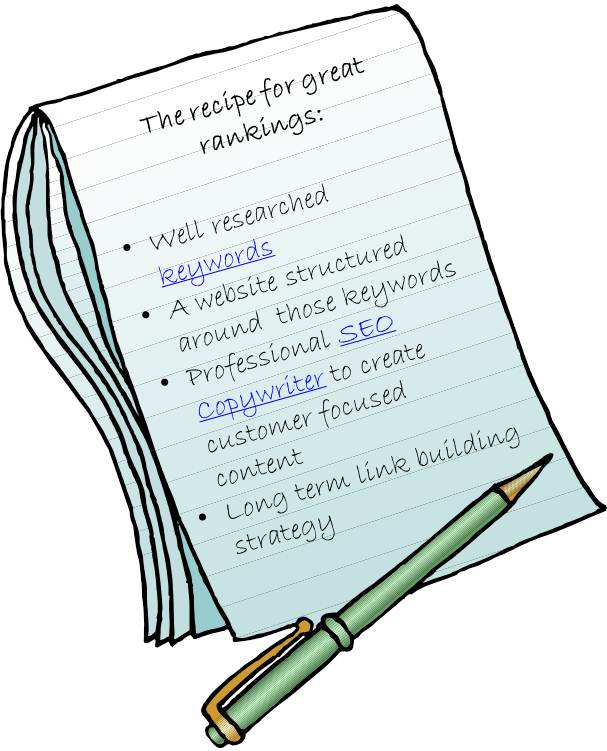Entries Tagged 'seo website copywriter' ↓
April 25th, 2012 — effective copy, keywords, search engine optimisation, seo, SEO copywriter, seo website copywriter
Keyword density is one of those phrases from the past that should be buried.
In the bad old days of SEO (search engine optimisation), it was thought to be the best on-screen method of boosting your search rankings.
The problem behind this thinking was that if you had 10 instances of your keyword or phrase on your web page, but a competitor had 15, they would rank higher than you.
Can you see where this is going?
That’s right – the end result was a list of search results that took you to unreadable, unimaginative and very uninteresting content.
SEO the right way
Thankfully, most SEO copywriters today understand the value of natural copy that is written for the reader and not the search engines.
You see, if you write in a natural style about a particular subject, the keywords will appear and at a level that you would expect. The result is great information that is easy to read and that will help your on-screen SEO strategy.
If you think this is all stuff and nonsense and that having a certain percentage of keywords is still the way to go, have a read of this from Google’s very own Matt Cutts (speaking at SXSW earlier this year):
“What about the people optimizing really hard and doing a lot of SEO. We don’t normally pre-announce changes but there is something we are working in the last few months and hope to release it in the next months or few weeks. We are trying to level the playing field a bit. All those people doing, for lack of a better word, over optimization or overly SEO – versus those making great content and great site. We are trying to make GoogleBot smarter, make our relevance better, and we are also looking for those who abuse it, like too many keywords on a page, or exchange way too many links or go well beyond what you normally expect. We have several engineers on my team working on this right now.”
Be natural
So there you go, if you continue to over stuff your content with keywords it will damage your website in the long run as well as having an immediate effect on your conversion rate.
Good SEO copy is:
- Natural
- Written for your reader
- Simple to understand
- Well laid out
It really is as easy as that.
October 24th, 2011 — copywriter, copywriting tips, marketing, SEO copywriter, seo website copywriter
 Have you noticed how different ideas spring up from time to time?
Have you noticed how different ideas spring up from time to time?
It’s the same in the marketing world. Every now and then someone comes up with, what appears to be, a brilliant idea. Every one jumps on the bandwagon, only to discover after a few months or a year that it doesn’t actually work at all.
It’s the same in copywriting. Take SEO copywriting as an example. At the outset, marketers would go to great pains to tell you that your copy had to contain a certain percentage of your keywords. The fact that this stipulation usually resulted in complete gibberish, didn’t seem to matter.
“It’s what the search engines want”
And like good little marketers we all followed suit and merrily stuffed our copy with keywords. Finally, people have seen sense and realised that good SEO copy is written for the reader – it should be:
- Interesting
- Relevant
- Of simple construction
- Contain loads of subheadings and bulleted lists
- …oh, and the odd keyword.
Basically, if you want your copy to work (regardless of its use), just follow the copywriting ‘rules’ that have stood the test of time.
Copywriting hints set in stone
1. Sell
You are writing copy for one reason, and one reason only – to sell.
Simply describing a product or service won’t convince anyone to buy it. So forget your flowery, adjective-laden text, make every word count and every word sell.
2. Formula
Don’t try to reinvent the wheel. Always use a tried and tested copywriting formula you know works:
- Understand your objective
- Clarify the main benefits
- Show how those benefits are delivered and how they will have a positive effect on your customer
- Back up your claims with evidence (testimonials, test results etc.)
- Sprinkle with sugar – make a time limited offer or give something free that will be of value to your customer
- Tell them to buy in your call to action
3. Command
If you write waffle that’s very wishy-washy, no one’s going to take you, or your product, seriously. Be forthright in your language.
Don’t ask them to…
“Call us, you know, if you have time, we don’t want to put you out.”
Tell them…
“Call now and make sure you don’t miss out on the offer of a lifetime.”
4. Clear benefits
It is the benefits of your product that will sell it. By benefits, I mean what it will do for your customer. It could save them money, streamline their business processes, or make them more attractive…
Try and stick to the primary benefit in your copy – the one that will really make a difference to them – make sure you tell them enough to make them say ‘yes’ and use it in your headline.
5. Offer
Whatever your offer is, make sure it’s a strong one that your customers will want.
6. Guarantee
Everyone loves peace of mind, so offering a guarantee will encourage your reader to trust you enough to buy from you.
7. Respond now!
Your strong call to action (mentioned in number 3) will tell your reader what you want them to do, but you have to give them a reason.
Making a limited offer will create a sense of urgency and force them to make a buying decision. It might be that the price is only held for 30 days, there is a limited number of your product available or they’ll receive a free gift if bought before a certain date.
8. Make it easy
If you want your reader to order from you, don’t make them jump through hoops.
You want to create as simple a process as possible, otherwise they won’t bother.
9. Free
Yes, using the word ‘free’ does work. People love to get something for nothing; it’s definitely a hot word worth using.
Over to you
These copywriting hints have served marketers well over the years, but the list is by no means exhaustive.
Can you add to it? If so, leave a comment below and let’s see how many tips we can come up with.
August 31st, 2011 — search engine optimisation, seo, SEO copywriter, seo website copywriter, website copywriter, website copywriting

From that list of ingredients, this post will look at the power of SEO copywriting.
When done well it will help your search engine rankings, attract readers and convert them into sales.
Done badly it could harm your rankings, repel customers and won’t convert a sausage.
So how can you make sure you get it right?
5 signs of good SEO copy
1. Write for your reader
There is a popular misconception that SEO copy has to be written for the search engines.
Wrong.
When writing your copy, always write it for your reader. Forget about keyword density – Google is more concerned with the amount of text, the topic you’re writing about (i.e. that your keywords in your title tags etc., are aligned with your content) and how hot the competition is for your particular keywords.
Always, always, always write to your reader first and foremost because they are the ones you want to read your copy and they are the ones you want to buy from you.
2. Don’t be repetitive
How many times have you read a website only to constantly hear the keywords being repeated?
Don’t stuff your copy with your keywords so it gets repetitive. After all if that was the only factor Google was interested in, all your competitor would have to do is insert one more keyword than you to rank higher.
And if that happened, the internet would be full of keyword-stuffed gibberish.
3. Don’t forget to link out
You already know the benefit of links into your website as part of your SEO strategy but don’t forget to link out too.
Linking out to authoritative articles not only adds to your reader experience and keeps Google happy; it could also help you attract inbound links.
4. Structure
Writing for the web is just like writing for anything else.
Your copy must be structured and attractive to the eye if you want people to read it.
Make sure it has a beginning, middle and an end with a strong headline. Split up your text into small paragraphs using sub headings as sign posts to help your reader skim the text.
Also, headings and subheadings are the ideal places for your primary and secondary keywords.
5. Be natural
There are loads of software programmes out there than can automate or spin articles for you. But they are no substitute for a well-considered, well-structured and well written article.
Don’t be tempted to use shortcuts.
So the moral of this post is to forget keyword density when it comes to your SEO copy. The most important thing to remember is to write for your reader. They are the ones you want to attract and they are the ones who you want to buy from you
July 15th, 2011 — search engine optimisation, seo, SEO copywriter, seo website copywriter
 There’s a lot of great SEO copywriting out there but there’s a lot of bad stuff too.
There’s a lot of great SEO copywriting out there but there’s a lot of bad stuff too.
Once upon a time it was considered that the only way to get your website to rank well was to create content that was purely targeted for the search engines. Inevitably, this resulted in a mountain of websites (and articles) that were stuffed to the rafters with keywords rendering the text unreadable.
Such as:
Brian is an SEO copywriter. He has been working with SEO clients for many years and excels in producing SEO copywriting that works. Through SEO copywriting he gains exceptional rankings for his clients. His SEO copywriting skills have been applauded the world over with his SEO clients the first to recommend his talents. “SEO is the way forward” said Brian, “SEO is what helps my clients get in front of their customers. Without SEO many didn’t get great online sales but now I have worked on their SEO copywriting they are getting more traffic.”
Yuk.
The sad thing is there are still a lot of people out there who think this works.
As more and more people realise that content marketing (articles, blogs and website copy) is the best way to get noticed, more and more badly written content is appearing.
If you want your content to get ranked and attract readers, here are a few things to bear in mind.
How to get your content read
1. Write for people
You may well be scratching your head thinking “Who else would I be writing for?”
Well most people, who generate content like the example above, don’t write for people. They are writing for the search engines by over stuffing their copy with keywords.
Writing for your reader is the most important thing. Naturally, you will include your keywords anyway so there’s no need to stuff them into every sentence you write.
2. Don’t be boring
When you try to boost the frequency of your keyword within your article you end up with something repetitive and boring. Plus if great rankings came solely down to the number of keywords you’d included you’ll end up in a ‘frequency war’ to see who can add the most. Therefore nothing that appeared on the web would be readable.
Therefore it is much better to keep your writing natural and concentrate on getting your keywords into other prominent on screen areas.
3. Maximising on screen SEO
To explain that last statement in number 2, the key on screen areas are in your headings (H1 and H2 etc.) and ALT tags for images.
Basically that means breaking down your article by using sub headings.
This not only gives more prominence to your keywords it also makes your article easier and more attractive to read.
Remember, the search engines will read every word of your articles but your reader will skim read and look at the sub headings.
4. Link out
Although you are trying to generate inbound links to your website through your content, it’s always a good idea to link out to other information.
After all, to create your article you would have probably done some research so why not link to it? Providing your reader with this extra information will add value and enhance your status as an expert in your field. And, with a bit of luck, might encourage more inbound links to your site.
5. Be natural
Last but not least, be natural.
As stated in number 1, you have to write for your reader first and foremost. But make sure the way you write is also accessible.
If you write in jargon and industry ‘speak’ you’ll reduce the accessibility of your work. Writing in simple language and in the second person (so you actually address your reader directly) will make it easier to read for everyone.
At the end of the day, natural copy will always do better than obvious SEO stuffing. Use simple language, plenty of sub headings and talk directly to your reader if you want to create content that ranks and is accessible to your reader.
April 25th, 2011 — Content marketing, copywriter, copywriting tips, online marketing, search engine optimisation, seo, SEO copywriter, seo website copywriter, small business web marketing, website copywriting
 Are you the type of person who breaks out into a cold sweat whenever you hear the term search engine optimisation?
Are you the type of person who breaks out into a cold sweat whenever you hear the term search engine optimisation?
To many it seems to be one of those mythical beasts that you can only tame if you’re armed to the teeth with an array of magical implements.
Well fear not for your knight(ess) in shining armour is here to save the day.
There are 5 very simple SEO checks you can make right now. Open up another browser window and pull up your website.
Ready?
OK, first things first. Let’s take a look at your website structure:
1. Looks aren’t everything
That’s something my mum was constantly telling me when I was growing up.
Take a look at your website – this one is especially pertinent for all owners of custom built websites. For many business owners the ‘look’ of their website is at the top of their list. It’s the part of the process that takes the biggest budget because they want theirs to be prettier than anyone else’s.
The problem with custom builds is that, sometimes, looks are at the expense of SEO, especially if you’ve been seduced by flash. Yes, it looks lovely but unless you’ve got some magic going on in the background coding it’s not going to help your search engine optimisation one jot.
Template websites – love them or loathe them – tend to be more SEO friendly from the start. If there are any web designers out there who want to disagree or comment further please do so, I’d love to hear your take on the design vs SEO debate.
Next we move on to how to get found in the first place, yup, the dreaded keyword research bit.
2. Keywords
Remember this post is all about simple SEO checks so I’m not going to delve into the realms of thorough keyword research.
Take a minute to jot down the top 3 words that you would use as a Google search to find your website.
For example I would choose copywriter, freelance copywriter and possibly Suffolk copywriter to get a geographical tag in there. Next ask a friend or colleague to do the same, in fact ask as many people as you like to do the same and eventually you’ll have a list of keywords.
You may not think that’s very scientific but it will give you keywords that real people would search under for you.
Next you do the hard bit and work out how competitive they are and which ones are the best to tackle (you’ll need to use something like Google’s free keyword research tool for this). The chart below should help you work that bit out.

It’s also a good idea, before you make any changes to your site, to search under the terms you decide on and write down your current ranking so you can watch in awe as your site rises ever higher.
That’s your keywords done, so what’s next? Well it’s back to your website.
3. All present?
If you want your site to rank for your identified keywords they need to be in your copy. That doesn’t mean cramming them into every sentence on the page. But rather weave them into the text in a couple of places.
Your headings and sub headings are always a good place to put them and in your title tags.
OK, so now you’ve got your words in your website copy, what’s next?
4. Power content
The next thing to do is write a page or blog post centred on your keywords (one for each keyword). Again that doesn’t mean stuffing, but using your keywords wisely (e.g. in a post of about 200-300 words, use your keyword 2 or 3 times).
Try and use it in your headings to give it more prominence. Once you’ve published these on your website you can then use them on your social media sites too (e.g. your Facebook page) and link back to your site using the keywords as your anchor text links.
With me so far? For the next bit you’ll need a bit of help.
5. Get votes
Every link that comes into your website acts like a vote of confidence in Google’s eyes. The more you have, the more authoritative you are.
So ask friends and colleagues to link to you (like a link exchange) using contextual anchor text links.
OK, so these 5 tips aren’t the most comprehensive SEO techniques but they can and will make a difference. So what have you go to lose? Give them a try and the come back and let me know how you get on.



 There’s a lot of great
There’s a lot of great  Are you the type of person who breaks out into a cold sweat whenever you hear the term search engine optimisation?
Are you the type of person who breaks out into a cold sweat whenever you hear the term search engine optimisation?




